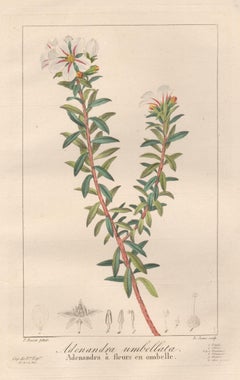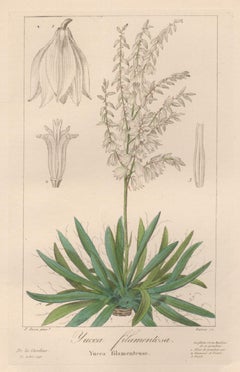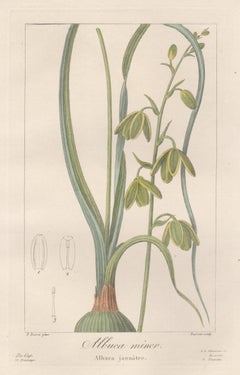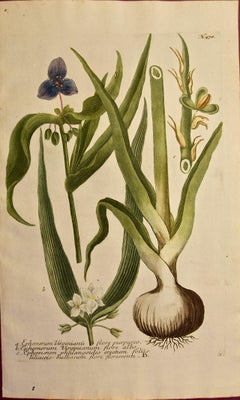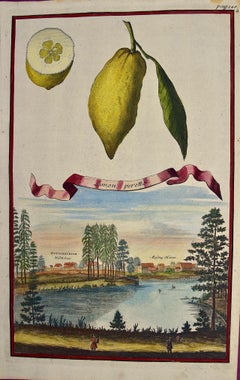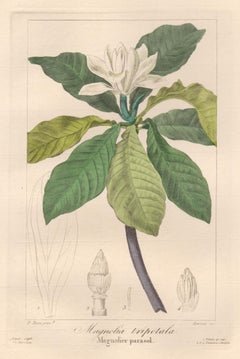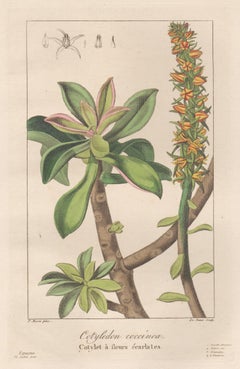After Pancrace Bessa Art
to
4
4
Adenandra umbellata - French botanical flower engraving by Bessa, c1830
By After Pancrace Bessa
Located in Melbourne, Victoria
'Adenandra umbellata'
Original copper-line engraving with original hand-colouring.
From 'Herbier general de l'amateur' by Jean Louis Auguste Loiseleur-Deslongchamps & Jean Claude M...
Category
Early 19th Century Naturalistic After Pancrace Bessa Art
Materials
Engraving
Apocynum androsamifolium - French botanical flower engraving by Bessa, c1830
By After Pancrace Bessa
Located in Melbourne, Victoria
'Apocynum androsamifolium' (Fly-trap dogbane or spreading dogbane)
Original copper-line engraving with original hand-colouring.
From 'Herbier general de l'amateur' by Jean Louis A...
Category
Early 19th Century Naturalistic After Pancrace Bessa Art
Materials
Engraving
Yucca filamentosa - French botanical flower engraving by Bessa, c1830
By After Pancrace Bessa
Located in Melbourne, Victoria
'Yucca filamentosa' (Adam's Needle)
Original copper-line engraving with original hand-colouring.
From 'Herbier general de l'amateur' by Jean Louis Auguste Loiseleur-Deslongchamps &...
Category
Early 19th Century Naturalistic After Pancrace Bessa Art
Materials
Engraving
Albuca Minor - French botanical flower engraving by Bessa, c1830
By After Pancrace Bessa
Located in Melbourne, Victoria
'Albuca Minor'
Original copper-line engraving with original hand-colouring.
From 'Herbier general de l'amateur' by Jean Louis Auguste Loiseleur-Deslongchamps & Jean Claude Michel M...
Category
Early 19th Century Naturalistic After Pancrace Bessa Art
Materials
Engraving
Related Items
Spider Lily: An Original 18th C. Hand-colored Botanical Engraving by J. Weinmann
By Johann Wilhelm Weinmann
Located in Alamo, CA
This colored botanical mezzotint and line engraving finished with hand coloring by Johann Wilhelm Weinmann (1683-1741) is entitled "A. Ephemerum Virginianu flore Purpureo, B. Ephemer...
Category
Mid-18th Century Naturalistic After Pancrace Bessa Art
Materials
Engraving, Mezzotint
$620 Sale Price
20% Off
H 15.75 in W 9.5 in
Lemons "Limon Peretto": An Early 18th Century Volckamer Hand-colored Engraving
By Johann Christoph Volkhamer
Located in Alamo, CA
This is an early 18th century hand-colored copperplate engraving of the anatomy of lemons by Johann Christoph Volkhamer, entitled "Limon Peretto" from his publication "Nurmbergische ...
Category
Early 18th Century Naturalistic After Pancrace Bessa Art
Materials
Engraving
$1,100 Sale Price
20% Off
H 14 in W 8.88 in
"February Bouquet" from 'The Twelve Months of Flowers' series by Robert Furber
By Robert Furber
Located in Alamo, CA
This framed hand-colored engraving entitled "February Bouquet" is from 'The Twelve Months of Flowers' by Henry Furber, published in London in 1730 by Robert Sayer and John King. Each of the twelve hand-colored engravings in the book were produced from paintings by Pieter Casteels (1684-1749) and engraved by Henry Fletcher (1710-1753). The book featured twelve detailed engravings of seasonal plants in bloom in the form of a bouquet. More than 400 different species of flowering plants were included with each plant numbered and accompanied by a list of the corresponding species names. Thirty-five species of flowers are depicted in this engraving in a bouquet sitting in an ornate attractive bowl. A few of the flowers lie loose on a table. The flower species are listed in a table in the lower portion of the plate, along with the month that these flowers are in bloom.
This colorful print is presented in a gold-colored wood frame with a cream-colored double mat with a heather green inner mat. The frame measures 23.5" High, 19" wide and 1.63" deep. There are a few small frame abrasions, but the print is in very good condition.
Robert Furber...
Category
Mid-18th Century Naturalistic After Pancrace Bessa Art
Materials
Engraving
$1,775
H 23.5 in W 19 in D 1.63 in
Lemons "La parte interiore": An Early 18th C. Volckamer Hand-colored Engraving
By Johann Christoph Volkhamer
Located in Alamo, CA
This is an early 18th century hand-colored copperplate engraving of the anatomy of lemons by Johann Christoph Volkhamer, entitled "La parte interiore del Cedro di fio e Sugo doppio" ...
Category
Early 18th Century Naturalistic After Pancrace Bessa Art
Materials
Engraving
$1,100 Sale Price
20% Off
H 14 in W 8.88 in
"Lilium Persicum" Ehret 18th Century Hand Colored Botanical Engraving
By Georg Dionysius Ehret
Located in Alamo, CA
A beautiful and important 18th century hand colored copperplate engraving of lillies which was most likely designed by Georg Dionysius Ehret (1708-1770) and engraved by Johann Michae...
Category
Late 18th Century Naturalistic After Pancrace Bessa Art
Materials
Engraving
$1,740 Sale Price
20% Off
H 27.5 in W 21.63 in D 1.13 in
Flowering Dragonmouth: 18th Century Hand-colored Weinmann Botanical Engraving
By Johann Wilhelm Weinmann
Located in Alamo, CA
An 18th century hand colored botanical engraving by Johann Wilhelm Weinmann (1683-1741) depicting the following flowering sage plants:...
Category
Mid-18th Century Naturalistic After Pancrace Bessa Art
Materials
Engraving, Mezzotint
$420 Sale Price
20% Off
H 17 in W 10.25 in
Flowering Houseleek Plant: A 19th C. Hand-colored Botanical Engraving by Curtis
By William Curtis
Located in Alamo, CA
This early 19th century hand-colored double fold-out botanical engraving is entitled "Sempervivum Glutinosum" (Clammy Houseleek), plate 1963, published in London in 1818 in William C...
Category
1810s Naturalistic After Pancrace Bessa Art
Materials
Engraving
$220 Sale Price
20% Off
H 11.75 in W 9 in
Red Geranium: An 18th Century Hand-colored Botanical Engraving by J. Weinmann
By Johann Wilhelm Weinmann
Located in Alamo, CA
This is an original antique colored botanical mezzotint and line engraving of flowering Red Geraniums which is finished with hand-coloring. It is entitled "Geranium Anemones folio Af...
Category
Mid-18th Century Naturalistic After Pancrace Bessa Art
Materials
Engraving, Mezzotint
$540 Sale Price
20% Off
H 15.25 in W 9.75 in
Flowering Morning Glory: 18th Century Hand-colored Weinmann Botanical Engraving
By Johann Wilhelm Weinmann
Located in Alamo, CA
This hand-colored botanical mezzotint and line engraving by Johann Wilhelm Weinmann (1683-1741) is entitled "A. Convolvulus Major Folio Subrotundo Purpureg Albo, B. Convolvulus Major...
Category
Mid-18th Century Naturalistic After Pancrace Bessa Art
Materials
Engraving, Mezzotint
$620 Sale Price
20% Off
H 15.75 in W 9.63 in
Flowering Lyons' Chelone Botanical: A 19th C. Hand-colored Engraving by Curtis
By William Curtis
Located in Alamo, CA
This early 19th century hand-colored double fold-out botanical engraving is entitled "Chelone Major" (Flowering Lyons' Chelone plant), plate 1864, published in London in 1816 in Will...
Category
1810s Naturalistic After Pancrace Bessa Art
Materials
Engraving
$220 Sale Price
20% Off
H 11.5 in W 9 in
Flowering Livid Amaranth: 18th Century Hand-colored Weinmann Botanical Engraving
By Johann Wilhelm Weinmann
Located in Alamo, CA
An 18th century color printed in addition to hand colored botanical mezzotint and line engraving by Johann Wilhelm Weinmann (1683-1741) depicting the following flowering amaranthus p...
Category
Mid-18th Century Naturalistic After Pancrace Bessa Art
Materials
Engraving, Mezzotint
$380 Sale Price
20% Off
H 17 in W 10.25 in
Orchids: Framed 19th C. Hand-Colored Engraving of "Laelia Anceps" by J. Fitch
By John Nugent Fitch
Located in Alamo, CA
This beautiful, original hand-colored orchid lithograph entitled "Laelia Anceps Williamsii" Orchids by John Nugent Fitch is plate 100 in Robert Warner's publication 'The Orchid Album...
Category
1880s Naturalistic After Pancrace Bessa Art
Materials
Engraving
John Nugent FitchOrchids: Framed 19th C. Hand-Colored Engraving of "Laelia Anceps" by J. Fitch, 1882
$780 Sale Price
20% Off
H 20.5 in W 17.25 in D 1.25 in
Previously Available Items
Magnolia tripetala - French botanical flower engraving by Bessa, c1830
By After Pancrace Bessa
Located in Melbourne, Victoria
'Magnolia tripetala'
Original copper-line engraving with original hand-colouring.
From 'Herbier general de l'amateur' by Jean Louis Auguste Loiseleur-Deslongchamps & Jean Claude Mi...
Category
Early 19th Century Naturalistic After Pancrace Bessa Art
Materials
Engraving
Cotyledon coccinea - French botanical flower engraving by Bessa, c1830
By After Pancrace Bessa
Located in Melbourne, Victoria
'Cotyledon coccinea'
Original copper-line engraving with original hand-colouring.
From 'Herbier general de l'amateur' by Jean Louis Auguste Loiseleur-Deslongchamps & Jean Claude Mi...
Category
Early 19th Century Naturalistic After Pancrace Bessa Art
Materials
Engraving
Virgilia Lutea - French botanical flower engraving by Bessa, c1830
By After Pancrace Bessa
Located in Melbourne, Victoria
'Virgilia Lutea' (Yellow Wood Tree)
Original copper-line engraving with original hand-colouring.
From 'Herbier general de l'amateur' by Jean Louis Auguste Loiseleur-Deslongchamps &...
Category
Early 19th Century Naturalistic After Pancrace Bessa Art
Materials
Engraving
Mimulus Glutinosus - French botanical flower engraving by Bessa, c1830
By After Pancrace Bessa
Located in Melbourne, Victoria
'Mimulus Glutinosus' (Monkey Flower)
Original copper-line engraving with original hand-colouring.
From 'Herbier general de l'amateur' by Jean Louis Auguste Loiseleur-Deslongchamps ...
Category
Early 19th Century Naturalistic After Pancrace Bessa Art
Materials
Engraving
Helianthemum halimifolium - French botanical flower engraving by Bessa, c1830
By After Pancrace Bessa
Located in Melbourne, Victoria
'Helianthemum halimifolium' (Sourwood or Sorrel Tree)
Original copper-line engraving with original hand-colouring.
From 'Herbier general de l'amateur' by Jean Louis Auguste Loisele...
Category
Early 19th Century Naturalistic After Pancrace Bessa Art
Materials
Engraving
Andromeda arborea - French botanical flower engraving by Bessa, c1830
By After Pancrace Bessa
Located in Melbourne, Victoria
'Andromeda arborea' (Sourwood or Sorrel Tree)
Original copper-line engraving with original hand-colouring.
From 'Herbier general de l'amateur' by Jean Louis Auguste Loiseleur-Deslo...
Category
Early 19th Century Naturalistic After Pancrace Bessa Art
Materials
Engraving
Laurus Cinnamomum - French botanical flower engraving by Bessa, c1830
By After Pancrace Bessa
Located in Melbourne, Victoria
'Laurus Cinnamomum' (True cinnamon tree or Ceylon cinnamon tree)
Original copper-line engraving with original hand-colouring.
From 'Herbier general de l'amateur' by Jean Louis Aug...
Category
Early 19th Century Naturalistic After Pancrace Bessa Art
Materials
Engraving
Geranium striatum - French botanical flower engraving by Pancrace Bessa, c1830
By After Pancrace Bessa
Located in Melbourne, Victoria
'Geranium striatum - Geranier reticule'
Original copper-line engraving with original hand-colouring.
From 'Herbier general de l'amateur' by Jean Louis Auguste Loiseleur-Deslongcha...
Category
Early 19th Century Naturalistic After Pancrace Bessa Art
Materials
Engraving
After Pancrace Bessa art for sale on 1stDibs.
Find a wide variety of authentic After Pancrace Bessa art available for sale on 1stDibs. You can also browse by medium to find art by After Pancrace Bessa in engraving and more. Not every interior allows for large After Pancrace Bessa art, so small editions measuring 9 inches across are available. After Pancrace Bessa art prices can differ depending upon medium, time period and other attributes. On 1stDibs, the price for these items starts at $120 and tops out at $120, while the average work can sell for $120.
